Abstract
The increasing proportion of night consumption in the total daily consumption means the night economy has become an indispensable part of national economic development. However, early social science research on alcohol in the night economy and social science research on the night leisure industry dominated our understanding of the night city. Few researchers have built effective mathematical statistical models to explore the spatio-temporal distribution and regional interactions of the night economy. This paper presents a method to analyze the spatial and temporal distribution pattern of the night economy based on multi-source data. Firstly, K-Means++ and DBSCAN were used to cluster OD points to identify the gathering areas of night activities. Then, the local L-function in “flow space” was used to extract the aggregated flow of each aggregation area and analyze the regional interactions. Finally, the correlation between night activity and night service facilities was calculated by using geographic detector, and night activity and lighting were coupled by the profit and loss value. The research shows that this method can identify the main areas of night activity, dig out the interrelationships at the community level, and find the new night activity gathering points and night economic growth areas in the future. This study extends the current situation that the night economy is limited to theoretical research and research in central urban areas, provides the temporal and spatial distribution of night activities and night lighting supplies from the perspective of big data, and provides a basis for future night economy research, urban planning, and relevant policy issuance.
1. Introduction
With the emergence of concepts such as the “nighttime economy” [1] and the implementation of strategies like the “18-h city” [2], the UK’s urban economy has witnessed a twofold growth [3]. Research on the night economy began to emerge. In the 21st century, theories about the night economy have become more abundant. The connotations, characteristics, functions, and factors influencing the night economy have been elaborated [4]. Based on governmental policies related to the nighttime economy, scholars have investigated the evolutionary mechanisms of these policies [5], and urban management planning for nighttime [6]. The study of the night economy is no longer confined to British cities [7]. Currently, the term “nighttime economy” primarily refers to economic activities predominantly centered on the service sector, occurring in urban spaces during the nighttime [3]. Its formats encompass activities such as nighttime shopping, dining, travel, and entertainment [8].
However, geographical practice has not kept up with the development of the theory. “Night-time economy” in the early research in the UK refers to a mixture of social science studies of alcohol and social science studies of the night-time leisure industry that have come to dominate how we understand nighttime cities [9]. Although there are is lot of geographical research on the night economy, researchers are still mainly focused on alcohol and violence, such as the concentration of potential nighttime crime zones [10], the impact of the nighttime economy on sexual violence [11], the relationship between the nighttime economy and alcohol-related violence [12], the costs of alcohol-related violence [13], and the dominant role of university students in bars [14]. Other scholars focused on ecological issues arising from the rapid growth of the nighttime economy, such as “light pollution” [15]. Although some scholars began to shift their attention to the temporal and spatial distribution of the night economy, the inefficient survey data they used made the study area only the central urban area and the important night commercial district [16,17,18]. There is a lack of mathematical statistical models and efficient data applied to analyze the spatial distribution of the night economy and to visualize it in research on the night economy.
Lighting is a necessary condition for modern human production and life at night. With the development of image enhancement and processing technology [19], satellite images of nighttime lights are increasingly applied to estimate economic growth [9], evaluate the development level of townships and transport hubs [20], visualize the spatial distribution of the GDP [21], explore human mobility [22], and identify regional economic centers [23]. However, these researchers ignored that a night light image itself is a direct reflection of the illumination at night. Night radiance images are more suitable for analyzing the development situation of the night economy.
Points of interest (POI) are widely used for studying the spatial distribution of various facilities due to their accurate geographical location and abundant types [24]. But day and night are different [9]. Researchers often do not explicitly consider the time validity of approaching POIs [25]. Dai W X (2021) divided the time of POIs according to experience and obtained a more accurate trip purpose, which proves that POI data need to consider the time [26]. Therefore, POI data can be used to analyze night facilities after being categorized by the hours of operation (i.e., after assigning time attributes).
Other data with temporal and geographic attributes, such as taxi origin–destination (OD) data, can be directly used to study night travel characteristics and intensive interactions between regions after screening. Common methods for OD data visualization include OD matrices [27] and mapping OD flows with different colored line segments [28]. However, there are deficiencies in extracting the main information of OD flows. Researchers used OD flow as a second-order form of points to divide the origin–destination clusters into different types, and also took advantage of the directional characteristics of OD data and processed them as vectors [29,30,31]. Cosine similarity has also been applied to vector extraction [32]. However, these methods cause a significant loss or distortion of the information of the flow. In order to retain the characteristics and geographic information of the flow, some scholars tend to take “flow” itself as the research object and actively apply the relevant theory of “point space” to the OD flow. Extending conventional approaches, measures of global and local spatial associations for flows were proposed, and the associated statistical properties and significance testing were discussed [33]. Hierarchical clustering and density clustering were combined to extract flows of different lengths and directions to reduce information loss in the clustering process [34]. The local K-function was also applied to the clustering of OD flows within a certain range [35]. Entropy theory and probability distribution functions were applied to search for adjacent OD flows within a certain radius of each OD flow to extract clustering flows and find the strongest spatial connection [36]. Through the development of point space theory to flow space, Gao Y Z et al. (2018) proposed the definition of “flow space” as the Cartesian product of OD flow [37] when comparing the motion modes of flows with the statistical method of multidimensional space. Subsequently, Pei T et al. (2020) further enriched the theory of “flow space,” including the density definition of flow, multiple distance definitions and types of flow, and multiple modes of flow [38]. Based on the “flow space” theory, Shu H et al. (2021) employed Ripley’s K-function to derive the L-function for calculating the flow clustering scale [39]. Yan X R et al. (2023) further distinguished the spatial attributes of flow clustering on the basis of the L-function [40]. Based on the theory of flow space, this paper used the L-function to calculate the cluster scale, and used the local L-function to extract the cluster flow.
In summary, this study selected Xiamen City as its research subject and employed various data sources, including taxi origin–destination (OD) data, POIs, and night light radiation to fill in the research on the relationships between night activity and the economy. In this study, the main night activity area is identified as Jiangtou to Zhongshan Road. Wuyuanwan and Lujiang Wharf are potential areas for development, and a comprehensive business format is more attractive. Finally, the findings of this research hold positive implications for enhancing infrastructure utilization rates and can also provide valuable insights for urban nighttime economic development and policy formulation. This study can provide a new big data perspective for the study of the night economy and fill the gap between the field of the night economy and the field of human behavior.
2. Study Area and Data Processing
2.1. Study Area
Xiamen City is situated at the southeastern extremity of Fujian Province in China, encompassing the primary landmass of Xiamen Island, the inland region of Tong’an, and other adjacent territories. It exercises jurisdiction over a total of six administrative districts, inclusive of Siming and Huli, as depicted in Figure 1. For the scope of this study, consideration is limited to the mainland territory and the principal landmass of Xiamen Island, omitting the assessment of offshore islands inaccessible via established roadways. The city is endowed with a sophisticated intra-city transportation infrastructure, as evidenced by the cumulative tally of 80.52 million taxi and commuter journeys undertaken during the year 2019, culminating in a daily average of approximately 220,600 trips. Xiamen City has garnered international recognition as a preeminent tourist hub, having registered an aggregate influx of 74.9911 million visitors both domestic and international, during the span of January to September. This surge in visitors precipitated a substantial total tourism revenue amounting to 118.622 billion yuan. Furthermore, the city’s prominence in the domain of nocturnal economic activity was underscored by its selection as one of the “Top 10 Cities in Nocturnal Economics” for the year 2019 [41].
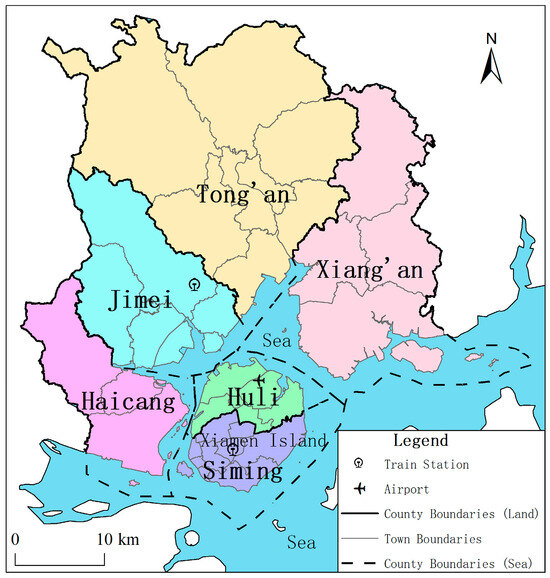
Figure 1.
Xiamen City administrative district map 2019.
2.2. Data Source and Processing
- (1)
- Nocturnal Radiance Image
This study employed monthly mean radiance composite images from June 2019 produced by The Earth Observation Group of NOAA’s National Environmental Information Center using VIIRS Day/Night Band, with a spatial resolution of 500 m. These images have been subjected to preliminary processing steps, including sensor calibration, when downloaded to the NOAA website “https://ngdc.noaa.gov (accessed on 9 September 2021)” and they contain floating point radiance values with units in nanoWatts/cm2/sr. Note that the original DNB radiance values have been multiplied by 1 × 109. In this study, the monthly average radiation composite images from April, May, and June 2019 were selected for continuity correction (as shown in Equation (1)):
In Equation (1), DN denotes the value of radiance; t stands for image; and i represents the pixel cells in the image.
This study reclassified the radiance values of the pixel grids with radiance values below 0.3 to 0.3 to ensure the exclusion of aberrant values from Figure 2 [42].
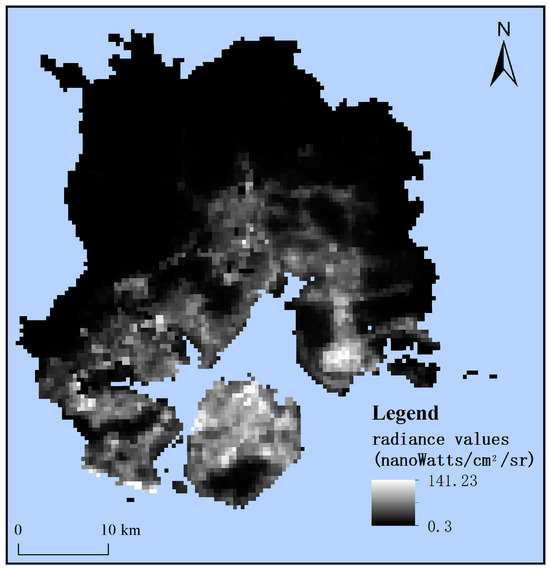
Figure 2.
Radiance map of Xiamen City June 2019.
- (2)
- Origin–Destination (OD) Data
The corpus of OD data pertaining to taxi journeys within Xiamen city during the temporal span encompassing 3 June 2019 to 9 June 2019 (Monday to Sunday) was systematically sourced from the official repository of the Xiamen Big Data Security Open Innovation Application Competition “https://data.xm.gov.cn/opendata-contest (accessed on 11 September 2020)”. This dataset embodies a quintet of distinct attributes: the unique identifier of the taxi, the temporal point of embarkation, corresponding geospatial coordinates, the temporal point of disembarkation, and the respective geospatial coordinates. Temporally stratified by 7 June 2019 (Friday, commemorating the Dragon Boat Festival), the dataset was dichotomized into weekday and holiday segments. Guided by the prevailing average diurnal transition times for sunrise and sunset in Xiamen during the stipulated period, the analytical window was defined as commencing at 19:00 and concluding at 5:00 the ensuing day. This temporal window was bifurcated into two discrete epochs: early night (19:00 to 0:00, exclusive of 0:00) and late night (0:00 to 5:00). In order to attenuate stochastic variance, the amalgamation of early night data across all weekdays was undertaken, analogous measures being applied to other designated study periods. Following a regimen of data refinement, a sum total of 586,056 meticulously curated records were produced, as meticulously chronicled in Table 1.

Table 1.
Cab OD data for Xiamen from 3 June 2019 to 9 June 2019.
- (3)
- Point of Interest (POI) Data
In this study, the Python programming language was employed to invoke the Amap API “https://lbs.amap.com (accessed on 16 September 2019)”, enabling the extraction of POI data spanning from 22 August 2019 to 16 September 2019, across ten distinct service sectors within Xiamen city. These sectors encompassed domains such as dining, retail, lodging, and others. The POI dataset exhibited negligible fluctuations over the course of the annual cycle, rendering it a robust representation of the entire year of 2019. Following a meticulous data refinement process involving deduplication and the exclusion of incomplete records, a dataset comprising 148,517 valid entries was curated, as depicted in Table 2.

Table 2.
2019 Xiamen City POI Data.
To capture the dynamics of urban transportation, taxi origin–destination (OD) data were harnessed. To distinctly discern taxi-associated mobility, the selected transportation facilities exclusively encompassed airports, railway stations, high-speed rail terminals, and their auxiliary amenities. Consequently, in subsequent discourse, the terminology “transportation activities” exclusively pertains to long-haul transportation modalities encompassing air travel, train excursions, high-speed rail journeys, and similar endeavors.
- (4)
- Land use
This study collected the land use of Xiamen City from the Resource and Environment Science and Data Center of China “https://www.resdc.cn (accessed on 20 December 2021), and divided construction land into urban land, rural land, and other construction land, with a spatial resolution of 1000 m, as shown in Figure 3.
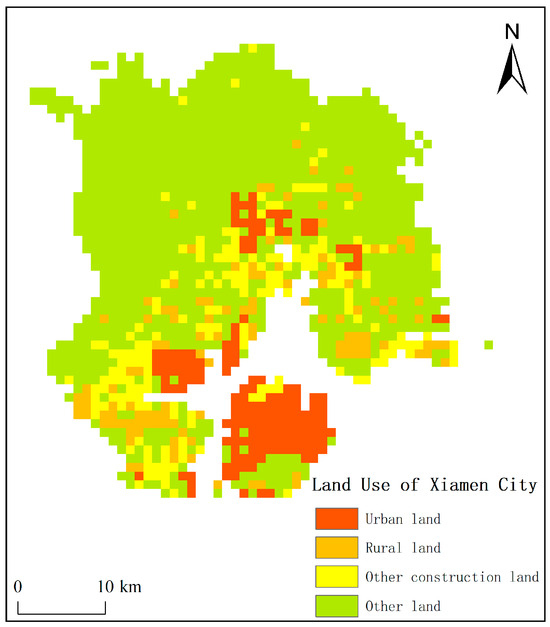
Figure 3.
Land use of Xiamen City 2020.
3. Materials and Methods
This study introduces a multifaceted methodology for investigating the spatiotemporal distribution patterns characterizing the nocturnal economy, rooted in the richness of diverse data sources. By meticulously examining the nocturnal activities and the lighting demand dynamics, this study formulated a comprehensive understanding of the intricate relationship between them. The analytical framework encompassed a nuanced dissection of the spatiotemporal patterns of the behavior of nocturnal consumers. This investigation delved into the nuanced impacts various service facilities exert upon nocturnal activities, unraveling the complexities of their influence.
To ensure the coherence and comparability of the data, this research devised a unified data formatting protocol, specifically focusing on spatial standardization. Anchored in the minimum scale of the grid data employed herein (characterized by a spatial resolution of 500 m for nighttime light data), this standard aligns with the spatial range identified by Steiner [43] in relation to human activities—comprising 500 m. Conforming to this spatial scale, a finely calibrated 500 m × 500 m grid structure was established, seamlessly integrating diverse experimental findings for subsequent calculations encompassing diverse parameters, including profitability evaluations. A graphical representation of the proposed methodology is eloquently captured in Figure 4:
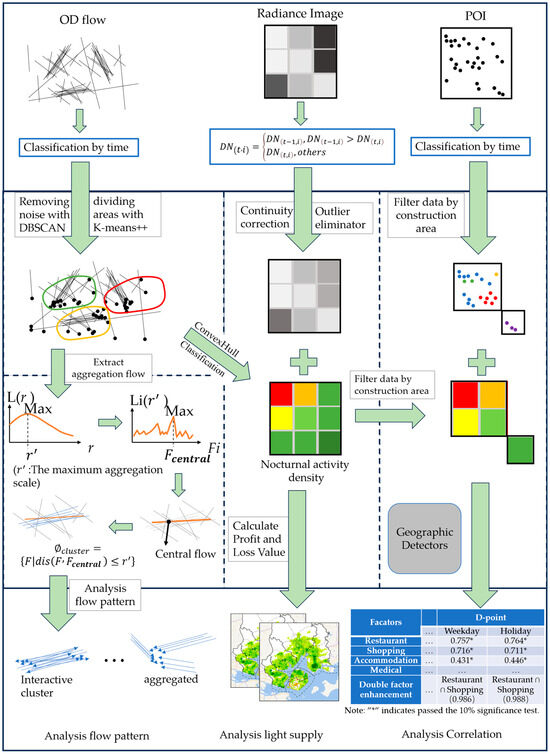
Figure 4.
Overall framework for this article.
3.1. Identification of Night Activity Gathering Areas
This study draws upon a dataset encompassing 12,460 taxi origin–destination (OD) records within Xiamen City during a specific hour (20:00 to 21:00) on a designated day in 2019. The algorithm’s optimal clustering outcome is deduced through the amalgamation of the Silhouette Coefficient and CH (Calinski–Harabasz), depicted visually in Figure 5a, where the DBSCAN noise ratio is 3.76% and the optimal cluster of K-Means++ and Mean-Shift is 39 and 8. However, DBSCAN and Mean-Shift diminish significantly in scenarios involving extensive high-density spatial configurations. thereby precluding the execution of refined clustering subdivisions for the central Xiamen Island region. Concurrent K-Means++ is inherently unable to discern peripheral regions characterized by noise disruptions.

Figure 5.
Results of the Taxi D-point clustering experiment. (a) DBSCAN; (b) K-Means++; (c) Mean-Shift. Note: Different colors represent different clusters after clustering.
The clustering results in Figure 5 indicate that employing a singular algorithmic approach for the clustering of Xiamen City proved inadequate in achieving desirable results. This study harnessed the synergistic merits of both DBSCAN and K-Means++ through a two-stage clustering methodology: in the initial stage, DBSCAN was enlisted to effectively excise noise regions from the dataset, thereby enhancing data fidelity. In the ensuing stage, a secondary K-Means++ clustering procedure was applied to the interregional clusters that were identified by DBSCAN, promoting a more nuanced and refined partitioning of the dataset. The specific denoising and second partition are shown in Figure 6.

Figure 6.
Process of point clustering. Note: Different colors represent different clusters after clustering.
Then, we calculated the density of the cluster with ConvexHull in sklearn. Lastly, employing the natural break classification method, the amalgamated clusters were classified into five distinct density levels: high, relatively high, medium, relatively low, and low. This stratification culminated in the identification of five distinct nocturnal activity agglomeration zones, characterized by their respective density attributes.
3.2. Aggregated Flow Extraction Methods
The following introduces the theoretical knowledge of flow, including flow space, distance between flows, fluid volume, and flow density.
- (1)
- Flow Space
Origin–destination (OD) flows represent events with temporal and geographical attributes. In a two-dimensional space, OD flows can be simplified as ((xO, yO), (xD, yD)). Viewing the planes containing the O and D points as two separate two-dimensional planes, the O and D points along with their neighborhoods within radius r, when projected onto their respective two-dimensional planes, collectively constitute a four-dimensional space denoted as “flow space” [39,40], as illustrated in Figure 7. Once two regions have a spatial interaction relationship, they can be called a “flow space.”
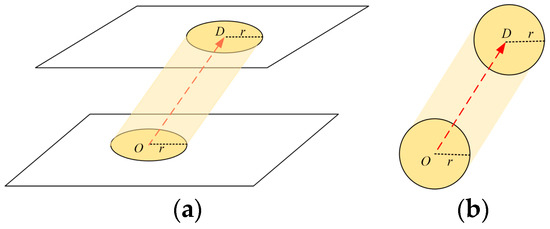
Figure 7.
Schematic diagram of flow space. (a) Flow space (R2 × R2); (b) Projection of flow space on a two-dimensional plane.
- (2)
- Distance between Flows
There are several flows in a flow space. The concept of “distance between flows” is introduced for two-dimensional planes. A variety of lengths can be used to measure the distance between two lines. In this study, the distance length of two flow points O and D are used to calculate the distance between flows, as depicted in Figure 8. According to the different combination rules, different distances between flows are derived, including maximum distance, summation distance, average distance, and weighted distance [39].
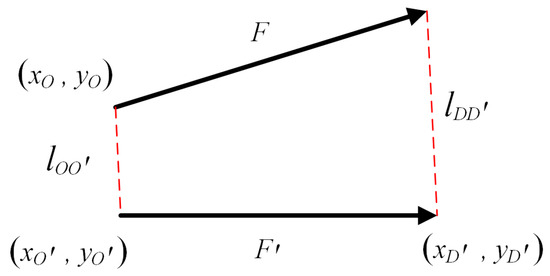
Figure 8.
Distance of flow.
- (3)
- Fluid Volume
According to the definition of “fluid space,” the formula for defining the “fluid volume” is presented as follows:
In Equations (8) and (9), F represents an arbitrary flow; ∅ denotes the set of all flows with a distance less than r from flow F; dis (F, F′) represents the distance between flow F and flow F′; SO indicates the area of the neighborhood around point O with a radius of r; and SD indicates the area of the neighborhood around point D with a radius of r. The volume of a four-dimensional hypersphere with a radius of r in the Euclidean distance metric can be computed by integrating two-dimensional circles of radius r and another two-dimensional circle of radius r, as expressed by the following formula:
Therefore, in this study, the fluid volume for various stream distances is calculated based on Equation (9), as demonstrated below:
In Equations (11) and (13), the symbol “r” represents the neighborhood, “Vmax” denotes the fluid volume based on the maximum distance, “Vadd” represents the fluid volume based on the summation distance, and “Vavg” corresponds to the fluid volume based on the average distance.
- (4)
- Flow Density
Flow density refers to the number of flows within a unit volume of flow space [39]. The estimation of flow density can be achieved using the second-order characteristics of the flow. The formula is as follows:
In Equation (14), ρF represents the flux density of flow F, V denotes the fluid volume per unit flow space, and n signifies the flow quantity within a unit flow space.
Ripley’s K-function enables the analysis of clustering tendencies at different distances within a point dataset. The spatial Ripley’s K-function for a flow can be defined as the normalized expected value of the flow within a neighborhood of radius r in the flow space [40]. The L-function is normalized by Ripley’s K-function. The formula is given below:
In Equations (15) and (16), where ρF represents the density of the flow, when the distance between flow components Fi and Fj is less than r, σFij(r) = 1. Conversely, when the distance between flow components Fi and Fj exceeds r, σFij(r) = 0.
For each individual flow, the local L-function is obtained, as given by the following expression:
In Equation (17), Li(r) denotes the local L-function, with the remaining parameters being consistent with the preceding context.
Under the framework of Flow Space Theory, this study calculated L-function values at different radii, and selected the flow space radius corresponding to the largest L-function value as the optimal radius r’. Taking r’ as the radius of flow space, the Li-function value of each flow was calculated. The flow with the largest Li-function value was selected as the central flow, and all flows in the flow space with an optimal radius around the central flow were extracted as aggregation flows. The formula is given below:
In Equations (18)–(20), L’(r’) denotes the max value of the L-function; r’ denote the optimal radius of the flow space; FL″ denotes the central flow, which means the max local L-function when the r equal to r′; and ∅cluster denotes the cluster of flow, with the remaining parameters being consistent with the preceding context.
3.3. Geographic Detectors
The core theory of geographic detectors is based on the assumption that if an independent variable has a significant effect on a dependent variable, then the spatial distribution of the independent variable and the dependent variable should be similar. This study employees differentiation factor detectors and interaction detection in geographic detectors to find the impact of night service facilities on the nighttime economy [44]. A differentiation factor detector can detect the extent to which covariates explain the spatial differentiation of interaction Y, represented by the q value [45], expressed as:
In Equation (21), SSW denotes the within sum of squares of factor XS. SST denotes the total sum of squares.
You can check whether the q value is significant by looking up tables or using geographic detector software (version 2015) ”http://wwwgeodetector.cn (accessed on 2 September 2020)”. The value range of q is [0, 1], and the larger the q, the more significant the spatial differentiation of interaction Y. The larger the q, the stronger the explanation of covariates XS for interaction Y, and vice versa. Interaction detection can identify the interaction between different covariates XS, that is, to assess whether the combined action of covariate X1 and covariate X2 will increase the influence on interaction Y, or whether the influence of these covariates X on interaction Y is independent of each other, as shown in Table 3.

Table 3.
Types of interactions between two covariates.
4. Results
4.1. Identification and Analysis of Night Activity Agglomeration Areas
Taxis, serving as a predominant mode of urban transportation, epitomize a pivotal component of nocturnal trip demands for residents, with their origin points (O-points) signifying passenger pickup locations and destination points (D-points) accurately reflecting nocturnal activity areas. In view of this, the present study emanates from a “point-space” perspective to delineate clusters of nocturnal activities, leveraging the realm of Geomatics Science and Technology. By using secondary clustering, the night activity gathering area was obtained after denoising, secondary division, convex hull calculation, and density division. The mainland area of Xiamen is all low-density agglomeration areas, so this study focused on the situation of Xiamen Island, as shown in Figure 9 and Figure 10.

Figure 9.
From 3 June 2019 to 9 June 2019, O-point clustering in Xiamen City. Note: ①: Zhonghua and Lujiang; ②: Jialian; ③: Western part of Jiangtou; ④: Eastern part of Yundang; ⑤: Wuchun; ⑥: Eastern part of Jiangtou; ⑦: North-central part of Lianqian.
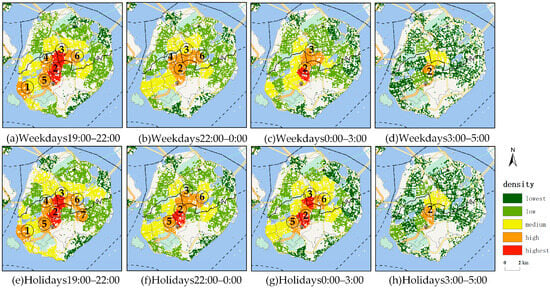
Figure 10.
D-point clustering in Xiamen from 3 June 2019 to 9 June 2019. Note: ①: Zhonghua and Lujiang; ②: Jialian; ③: Western part of Jiangtou; ④: Eastern part of Yundang; ⑤: Wuchun; ⑥: Eastern part of Jiangtou; ⑦: North-central part of Lianqian.
Areas with densities classified as high and above were considered as nocturnal activity aggregation areas. Temporally, on weekdays, the aggregation zones around midnight (referred to as “O points”) were most widespread between 19:00 and 22:00. These zones included Jiangtou, the north-central part of Lianqian, the eastern part of Yundang, the western part of Jialian, and Wucun, Lujiang, Zhonghua, and Xiagang (as shown in Figure 9a). After 22:00, the range of aggregation zones gradually narrowed. For the holiday O-point aggregation zones, the distribution ranged from 19:00 to 3:00, similar to that of weekday O-points from 19:00 to 22:00, and the range and density levels of the other aggregation zones changed little from 19:00 to 3:00. Subsequently, after 3:00, the range of holiday O-point aggregation zones abruptly contracted. The density of weekday O-point aggregation zones exhibited a gently decreasing trend (as shown in Figure 11a). But the density of holiday O-point aggregation zones displayed a reversed S-shaped decline, with an initial gentle drop followed by a sudden decrease (as depicted in Figure 11b).

Figure 11.
Schematic diagram of density changes in night activity gathering areas in Xiamen City. (a) Placid type; (b) Anti S-shape; (c) Undulate type.
Regarding weekday D-point aggregation zones, the most extensive distribution occurred between 19:00 and 22:00 (as shown in Figure 10a). Between 22:00 and 0:00, the range of aggregation zones gradually narrowed. Surprisingly, the nighttime activity density in the Jialian increased during this period, upgrading to a high-density level (as shown in Figure 10c, marked by ②). On holidays, compared to weekday D-point aggregation zones during 19:00 to 22:00, additional aggregation areas emerged in the eastern part of Jiangtou and the north-central part of Lianqian. Between 0:00 and 3:00, the nighttime activity density in the western part of Jiangtou increased, upgrading to a high-density region (as shown in Figure 10g, marked by ③). Therefore, the density of both weekday and holiday nighttime D-point aggregation zones displayed a fluctuating, declining trend (as presented in Figure 11c).
Consequently, the nocturnal activity density of Xiamen city gradually decreased outward from the geometric center of Xiamen Island, exhibiting a multi-ring distribution pattern. The clustering of nocturnal activity was the most significant on Xiamen Island. The density of the O-point and D-point in Jialian’s Lianban mixed commercial and residential area were the most densely populated areas for nighttime activities. The density change pattern of the O-point indicates that the demand for nocturnal activities in Xiamen is greater during holidays, with holiday aggregation periods extending by 3 h compared to weekdays. Nocturnal activities exhibit a secondary peak between 0:00 and 3:00.
4.2. Analysis of the Pattern of Night Activity Flow
Identifying the “flow” pattern of night activity can excavate the interactive relationship and dynamic connection within urban areas, divide urban function areas, and better understand the behavior pattern and dynamic mechanism of night activity.
Patterns of flow clustering can be classified into fundamental types: aggregated, dispersed, and aggregated–dispersed hybrids (as depicted in Figure 12a,c), and composite types exhibiting a combination of these fundamental patterns (as depicted in Figure 12d,f). The mean flow is utilized to indicate the direction of aggregated flows, with distinct colors representing the clustering scale.
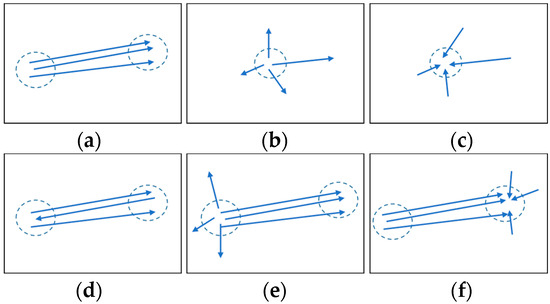
Figure 12.
Schematic diagram of the flow mode. (a) Clusters; (b) Dispersed; (c) Aggregated; (d) Interactive cluster; (e) Dispersed and clusters; (f) Aggregated and clusters.
This paper takes into consideration the “flow” attribute of OD (origin–destination) data. It excludes ultra-short-distance flows with lengths less than 1 km and defines a threshold based on the 3 km starting distance from Xiamen City’s 2021 taxi fare standards. Flows with lengths between 2 km and 3 km are categorized as short-distance flows, while flows with lengths exceeding 3 km are classified as long-distance flows. The “flow distance,” defined as the maximum distance within a flow, was used in conjunction with the L-function in “flow space” to compute the clustering scale of nighttime activities in Xiamen City. The maximum aggregation scale served as a parameter to employ the Li-function in discovering aggregative flows within clustered areas.
The extracted aggregation flows are shown in Figure 13 and Figure 14. Each cluster of aggregation flows represents the spatial interaction between an O-points region and a D-points region, that is, a flow space. The clustering scale of short-distance flow is less than 400 m. The clustering scale of long-distance flow ranges from 1000 m to 2900 m. Subsequently, an analysis of the distribution patterns of these flows was conducted.

Figure 13.
Short distance interaction area in the Xiamen Night Activity Cluster from 3 June 2019 to 9 June 2019. (a) Weekdays; (b) Holidays. Note: The aggregation flows of different colors represent that they are extracted from different night activity gathering Areas.
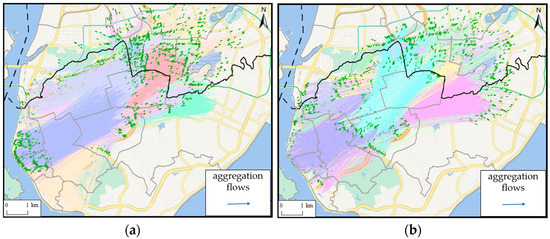
Figure 14.
Long distance interaction area in the Xiamen Night Activity Cluster from 3 June 2019 to 9 June 2019. (a) Weekdays; (b) Holidays. Note: The aggregation flows of different colors represent that they are extracted from different night activity gathering Areas.
There were many directions and modes of short-distance aggregated flow. On working days, the Zhonghua road business district to Xiamen University showed an interactive cluster. From the Xiamen train station business district to the Lianban mixed commercial and residential district was a cluster. The Lianban mixed commercial and residential district with the surrounding business circles and residential areas, including the Jiangtou residential district, the Jiangtou business district, the culture and art center of Xiamen City, Nanhu, and all parks showed as interactive clusters. Therefore, the Lianban mixed commercial and residential district was a variety of composite patterns of clusters, dispersed and aggregated. Compared to weekdays, the Ruijing plaza embraced a north-south discrete pattern. A cluster pattern was newly formed in the Zhonghua road business district to the Xiahe residential district.
In Figure 14, the long-distance aggregation flow reflects the interaction between the towns and is less expressive than the short-distance aggregation. The mean flow vectors inherently possess an aggregative attribute and could theoretically be considered as aggregated flows. Based on the distribution areas of mean flows and their orientations, flow patterns within the nocturnal activity were identified and explored (as presented in Figure 15).
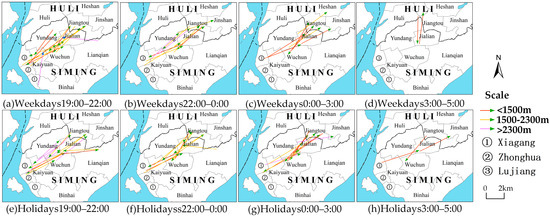
Figure 15.
Long-distance interaction area in the night activity gathering area of Xiamen City from 3 June 2019 to 9 June 2019.
From Figure 15, it can be observed that in the long-distance regional context, the aggregative flow patterns with cluster scales less than 2300 m exhibited predominant orientations toward the southwest and northeast directions. These patterns were concentrated primarily in the vicinity of Heshan to Zhonghua and Lujiang streets, characterized by predominantly cluster patterns and interactive cluster-compound patterns. During weekdays from 19:00 to 0:00, interactions of a cluster-compound nature were evident in the following flow segments: Jiangtou to Jialian and Wucun, Jialian and Wucun to Zhonghua and Lujiang, and Yundang to Lujiang and Kaiyuan. In the timeframe of weekdays from 0:00 to 3:00, an interactive cluster-compound pattern emerged in the Jiangtou to Wucun segment, while a unidirectional cluster pattern was observed in the Lujiang to Wucun segment. Between 3:00 and 5:00 on weekdays, the interactive region extended from the southern section of Dianqian to Jialian, characterized by an interactive cluster-compound pattern.
During holidays from 19:00 to 22:00, the flow directions were most dispersed, covering the central and southern regions of Xiamen Island. This dispersion was predominantly described by interactive cluster-compound patterns, including Jiangtou to Wucun and Yundang, Yundang and Wucun to Lujiang and Zhonghua, and Jialian to Lianqian in the central region. From 22:00 to 0:00 on holidays, only Jiangtou to Wucun and Wucun to Lujiang and Zhonghua exhibited an interactive cluster-compound pattern. In the holiday time frame from 0:00 to 3:00, the flow directions became more concentrated, primarily directed toward the northeast. The nocturnal activity areas showed a continuity in interaction patterns with the previous timeframe. Between 3:00 and 5:00, a continuous unidirectional flow pattern emerged from Lujiang to Jialian, extending to Jinshan.
Consequently, within the nocturnal activity hotspots of Xiamen City, long distance flow patterns primarily manifest as cluster patterns and interactive cluster–compound patterns, with the primary interactive region located between Jiangtou and Wucun, and Wucun and Lujiang.
4.3. Correlation and Analysis of Lighting Supply and Demand
4.3.1. Correlation Analysis
Human night activities are basically concentrated in the built-up area of construction land. According to the resolution of 500 m of a radiation map, this study divided Xiamen City into a 500 m grid and counted the number of service facilities and the radiation values in the grid. Employing the geographical detectors methodology, a comprehensive analysis was conducted to meticulously probe the far-reaching impacts of these nocturnal service facilities on nighttime activities (as delineated in Table 4).

Table 4.
Differentiation of night activity and night service facilities in Xiamen City from 3 June 2019 to 9 June 2019, and factor detector results (q value).
From Table 4, it can be observed that nighttime activities, such as dining, shopping, accommodation, residential, and entertainment facilities, had a significant impact on the density of nighttime activities. Conversely, nighttime scenery, transportation, educational, and medical facilities exerted a negligible influence on nighttime activities and could be disregarded. Additionally, the impact of the same facilities on the nighttime activity density of Xiamen City was relatively consistent between weekdays and holidays. Among the nighttime service facilities that influenced the density of point O, the core factors with q values exceeding 0.5 included nighttime dining, shopping, and entertainment facilities. Similarly, for the density of point D, the key factors with q values greater than 0.5 comprised nighttime dining, shopping, entertainment, and residential facilities. Consequently, when nighttime dining and shopping facilities were clustered and distributed, they exhibited a higher potential to attract consumers, making commercial districts with large-scale integrated malls and food streets the most concentrated areas of nighttime activities. All of the factors enhanced the correlation, with the strongest enhancement effect at the O-point being restaurant and work facilities, and the strongest enhancement effect at the D-point being restaurant and shopping facilities. Hence, the influence of nighttime service facilities in Xiamen City on nighttime activities remained relatively consistent between weekdays and holidays. Among these, the primary factors affecting nighttime travel activities included nighttime dining, shopping, and entertainment facilities, while nighttime recreational activities were additionally impacted by residential facilities.
4.3.2. Light Supply and Demand Analysis
The concentration area of D-points encapsulates the predominant distribution of nocturnal activity demands. Therefore, this study placed particular emphasis on the selection of the D-point concentration area. The objective was to ascertain the supply–demand relationship between this area and both nocturnal light availability and the provisioning of nocturnal services. Subsequent to this, an analysis of the distribution of supply and demand was conducted.
Both nocturnal activities density and nocturnal radiance image were reclassified into five distinct categories based on their density, each category being assigned a numerical value ranging from one to five. The profit and loss value of light was calculated by subtracting the radiation value after reclassification from the nocturnal activity density after reclassification. The nocturnal activity–lighting relationship is expressed within a range of surplus and deficit values spanning from negative four to three. Specifically, a surplus value ranging from negative four to negative one signifies an ample supply of nocturnal lighting, thereby constituting the “light surplus area.” Conversely, a deficit value within the range of one to four signifies an inadequate supply of nocturnal lighting, delineating the “light deficit area.” A value of zero represents the “light balance area” that denotes a state of equilibrium between the supply and demand of nocturnal activity, including the lighting balance and the dark balance.
Based on the data presented in Figure 16, it is evident that there existed a fundamental similarity in the distribution of lighting surpluses and deficits between weekdays and holidays. We took point D of the holiday as an example to show the distribution of supply and demand (see Figure 17 for details).
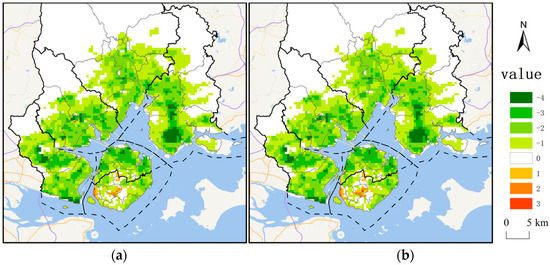
Figure 16.
Nighttime activities and lighting profit and loss distribution in Xiamen City from 3 June 2019 to 9 June 2019. (a) Weekdays; (b) Holidays. Note: Values spanning from negative four to negative one represents the light surplus area; Zero represents the light balance area; Values spanning from one to four represents the light deficit area.
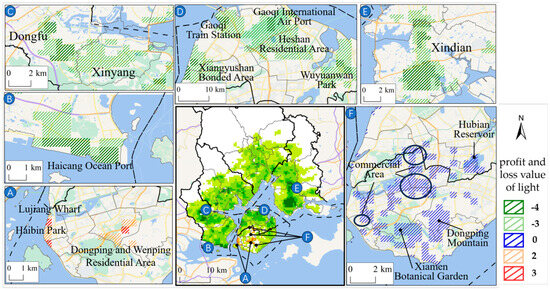
Figure 17.
Detailed distribution of supply and demand at the D-point of holidays. (A): light surplus area, (B–E): light deficit area, (F): light balance area.
Notably, areas characterized by a “lighting surplus” considerably outnumbered those exhibiting a “lighting deficit.” Extensive infrastructures such as Haicang Port, Xiamen Gaoqi International Airport, the Xiangyushan Bonded Area, as well as nascent developmental towns like Xindian and Dongfu were characterized by a notable surplus in lighting provision (as presented in Figure 17B–E). However, a distinct inadequacy in lighting supply was observed in the vicinity of the ferry terminal within the Lujiang wharf and Haibin park. The Dongping and Wenping community demolition and resettlement residential area lacks large commercial facilities and was also a light deficit area (as presented in Figure 17A). This phenomenon was pronounced in various locales, including the prominent commercial districts, where the equilibrium between lighting provision and demand was notably skewed toward lighting balance. Ecological areas such as Dongping mountain, botanical gardens, reservoirs and so on were in dark balance (as presented in Figure 17F).
5. Discussion
In recent years, nighttime consumption in China has accounted for 50% of the total daily consumption, with this proportion continuously increasing [46,47]. However, the majority of official statistical data have not distinguished between the nighttime and daytime economies, resulting in a lack of direct and effective data for research on the nighttime economy, thereby impeding its comprehensive investigation. Based on the theory of “point space” and “flow space,” this study determined the static distribution and regional interactions of urban economic activities at night.
A single point clustering algorithm has a poor clustering effect when there is a large range of high-density regions, so it is necessary to combine the advantages of multiple clusters. The noise is removed first, and then the large area of high density is divided twice. The L-function and Li-function used in mining clustering in this study showed that the clustering effect was more obvious in short distances than in long distances, which is more suitable for mining regional interactions at the community level: for example, the interactions and relationships between the Xiamen Culture and Art Center and between Jialia, and the new gathering center, Ruijing plaza.
The distribution of night activities and lighting supply in Xiamen City clearly showed that the four major commercial districts connected in series or that the commercial districts of mixed residential buildings (from Jiangtou to Lianban to the Xiamen railway station to Zhongshan Road) are the most prosperous areas in Xiamen at night, with a sufficient lighting supply, a dense flow of people, and great regional interactions.
Based on the calculation of light profit and loss value, it is obvious that the mainland area (namely, outside Xiamen Island) was weak in night activities from the overall perspective of Xiamen City. In many areas, the lighting infrastructure was perfect, but the night activities were not much, forming surplus areas of light, like Wuyuanwan Park. Compared with the census and statistical data limited to specific squares and tourist attractions on commercial streets [16,17], this study has the advantage of being more efficient and reflecting the situation more comprehensively.
Compared with studies on the influencing factors and patterns of the night economy only from theory [4,5], this paper found that catering, shopping, and entertainment are people’s favorite night consumption activities from the quantitative calculation results of the correlations. Interaction detection proved that a combination of large shopping malls and food courts was the most attractive. Recreational activities such as bars and clubs were not the only purpose of a night out. This provides a new direction for the study of the night economy in the future.
While a substantial volume of origin–destination (OD) data to a certain extent accurately represents residents’ travel characteristics, the limitations in data acquisition have confined this research to using exclusively taxi OD data, thereby diminishing the representativeness of the population. Regarding data timeliness, this paper employed the Dragon Boat Festival holiday as a representation of nocturnal holiday activities, thereby reducing the representativeness of nighttime activities during holidays. Consequently, future research could be expanded in the following directions: by integrating long-term sequences of self-driving and public transportation OD data into the spatiotemporal domain, discerning drop-off point semantics, and enhancing population representativeness during both workdays and holidays.
6. Conclusions
This paper provides an efficient and direct method for mining perceptual big data. Point clustering and flow clustering of the OD data well reflect the distribution and regional interactions of night activities. The present situation and potential of the night economy are reflected by combining the data of night lighting from crowd gatherings and the light supply. Xiamen Island is the main gathering area for night activities, among which the four main business districts or mixed residential districts are connected in series (from Jiangtou to Lianban to the railway station to Zhongshan Road) and are the most bustling areas in Xiamen at night, with a status unmatched by other areas. The mainland areas outside Xiamen Island, although also well equipped with harbors and new towns, are not as attractive for nighttime activities. The following suggestions are put forward for Xiamen’s urban planning and economic development:
- (1)
- From the lighting supply, it can be concluded that many areas on Xiamen Island have a good lighting supply and their own characteristics, such as the excellent yacht port and park in Wuyuan Bay. The ferry terminal area of Lujiang is the most convenient place to get to Gulangyu Scenic Island, and its night cruise program is attractive, but the construction of lighting infrastructure needs to be strengthened. These locations have great potential for development and can become new night activity gathering points and growth areas of the night economy.
- (2)
- The aggregated flow of the culture and art center of Xiamen City indicates that exhibitions and concerts are also new attraction factors. A combination of large shopping malls and food courts is the most attractive. Therefore, it is necessary to comprehensively develop a variety of night formats. Culture is the core of the economy, and we should fully rely on Xiamen’s abundant resources in commerce, tourism, culture, and sports, which should be effectively leveraged. Highlighting the distinctive Fujian, overseas Chinese, and Taiwanese characteristics can cultivate a distinctive nighttime economy. In particular, the new cities in the mainland region can only compete with Xiamen Island by relying on their distinctive culture.
- (3)
- Construction and publicity should be strengthened with new technologies. In terms of the construction of nighttime lighting infrastructure, innovations in technologies such as unmanned aerial vehicles can be employed to create large-scale lighting spectacles, thereby attracting nocturnal visitors. These installations can be imbued with urban cultural elements, blending scientific and technological displays with aesthetics and cultural connotations, thereby becoming symbolic representations of the city’s ethos. In terms of publicity, they can be widely disseminated through live broadcasting platforms to develop the “Internet celebrity economy”.
- (4)
- Market support and guidance should be strengthened. The advent of the “Internet celebrity economy” may lead to an influx of visitors, but it can also precipitate cutthroat competition within industries. Consequently, governmental authorities should devise corresponding policies grounded in regional contexts and distinctive industries. The aim is to foster a conducive consumption environment for the nighttime economy, mitigating unhealthy competition and steering the development of innovative nighttime economies.
Author Contributions
L.Z.: Writing—original draft, Writing—review and editing, Software, Data curation, Validation, Formal analysis. T.L.: Conceptualization, Methodology, Funding acquisition. Z.L.: Writing—original draft, Software, Data curation, Validation, Formal analysis. P.D.: Supervision, Writing–review and editing. Y.W.: Supervision, Visualization. All authors have read and agreed to the published version of the manuscript.
Funding
This research was funded by the State Key Laboratory of Geo-Information Engineering and the Key Laboratory of Surveying and Mapping Science and Geospatial Information Technology of MNR, CASM (grant number 2022-03-03); Major Project for Science and Technology of Gansu Province (grant number 22ZD6GA010); National Natural Science Foundation of China (grant number 42261076); and the National Natural Science Foundation of China (grant number 42061060).
Data Availability Statement
The URLs for obtaining data has been provided in the article. The OD data is related to privacy policies and may have exceeded the validity period for obtaining. If needed, please contact us via email.
Acknowledgments
We thank the reviewers for their comments of the reviewers, which were of great help to improve the quality of this paper.
Conflicts of Interest
The authors declare no conflicts of interest.
References
- Montgomery, J. Cities and the art of cultural planning. Plan. Pract. Res. 1990, 5, 17–24. [Google Scholar] [CrossRef]
- Comedia (Firm). Out of Hours: A Study of Economic, Social and Cultural Life in Twelve Town Centres in the UK—Summary Report; Comedia Publishing Group: London, UK, 1991. [Google Scholar]
- Bianchini, F. Night Cultures, Night economies. Plan. Pract. Res. 1995, 10, 121–126. [Google Scholar] [CrossRef]
- Mao, Z.G.; Long, Y.Y.; Ye, X. Research progress in night economy theory. Econ. Perspect. 2020, 2, 100–112. [Google Scholar]
- Chu, D.P.; Liao, J.W.; Xu, Y. Research on the evolution mechanism of China’s nighttime economic policy. Consum. Econ. 2021, 37, 20–27. [Google Scholar]
- Wang, J.J.; Zhou, Y.H.; Zhang, J.X. Summary of research on urban night economic development. Mod. Bus. Trade Ind. 2014, 8, 1–3. [Google Scholar]
- Zheng, X.C. Research on the Development of Nighttime Economy in Beijing. Master’s Thesis, Graduate School of Chinese Academy of Social Sciences, Beijing, China, 2021. [Google Scholar]
- McArthur, J.; Robin, E.; Smeds, E. Socio-spatial and temporal dimensions of transport equity for London’s night time economy. Transp. Res. Part A Policy Pract. 2019, 121, 433–443. [Google Scholar] [CrossRef]
- Avetisyan, S. Nightlights as a Proxy Measure in an Economy. 2020. Available online: https://ssrn.com/abstract=3609008 (accessed on 12 September 2022). [CrossRef]
- Haleem, M.S.; Lee, W.D.; Ellison, M.; Bannister, J. The ‘exposed’ population, violent crime in public space and the night-time economy in Manchester, UK. Eur. J. Crim. Policy Res. 2021, 27, 335–352. [Google Scholar] [CrossRef]
- Anitha, S.; Jordan Ana Jameson, J.; Davy, Z. A balancing act: Agency and constraints in university students’ understanding of and responses to dexual violence in the night-time economy. Violence Against Women 2021, 27, 2043–2065. [Google Scholar] [CrossRef]
- Kowalski, M.; Livingston, M.; Wilkinson, C.; Ritter, A. An overlooked effect: Domestic violence and alcohol policies in the night-time economy. Addiction 2023, 118, 1471–1481. [Google Scholar] [CrossRef]
- Deeming, S.; Kypri, K. Costing alcohol-related assault in the night-time economy from a societal perspective: The case of central Sydney. Drug Alcohol Rev. 2021, 40, 779–799. [Google Scholar] [CrossRef]
- Gant, R.; Walford, N.; Terry, P. Alcohol and personal security in the built environment: Student engagement in the night-time economy of Kingston upon Thames, London, UK. Lond. J. 2021, 46, 187–213. [Google Scholar] [CrossRef]
- Huang, C.H.; Ye, Y.; Jin, Y.H.; Liang, B.L. Research progress, hotspots, and evolution of nighttime light pollution: Analysis based on WOS database and remote sensing data. Remote Sens. 2023, 15, 2305. [Google Scholar] [CrossRef]
- Li, X. Problems and promotion strategies of night economy in integration of tourism and culture: A case study on taiping old street in Changsha. J. Yangtze Norm. Univ. 2023, 39, 9–16. [Google Scholar]
- Zhong, J.S. A Study on the Influence of Night Tourist Experience on Behavioral Intention in Historical and Cultural Districts: A Case Study of Three Streets and Two Alleys in Nanning City. Ph.D. Thesis, Guangxi Minzu University, Guangxi, China, 2023. [Google Scholar]
- Zhong, W.Q.; Wang, D. A study on the spatial characteristics of nighttime viyality in the city center of Shang Hai. City Plan. Rev. 2019, 43, 97–106+114. [Google Scholar]
- Liu, Q.Y.; Fan, J.F.; Zuo, J.W.; Li, P.; Shen, Y.P.; Ren, Z.P.; Zhang, Y. A Spatiotemporally constrained interpolation method for missing pixel values in the suomi-NPP VIIRS monthly composite images: Taking Shanghai as an example. Remote Sens. 2023, 15, 2480. [Google Scholar] [CrossRef]
- Chen, L.J.; Zhang, H.P.; Wang, Z.Q. Township development and transport hub level: Analysis by remote sensing of nighttime light. Remote Sens. 2023, 15, 1056. [Google Scholar] [CrossRef]
- Zhao, Z.Z.; Tang, X.J.; Wang, C.; Cheng, G.; Ma, C.; Wang, H.T.; Sun, B.K. Analysis of the spatial and temporal evolution of the GDP in Henan province based on nighttime light data. Remote Sens. 2023, 15, 716. [Google Scholar] [CrossRef]
- Rogers, G.; Koper, P.; Ruktanonchai, C.; Rogers, G.; Koper, P.; Ruktanonchai, C.; Ruktanonchai, N.; Utazi, E.; Woods, D.; Cunningham, A.J.; et al. Exploring the relationship between temporal fluctuations in satellite nightlight imagery and human mobility across Africa. Remote Sens. 2023, 15, 4252. [Google Scholar] [CrossRef]
- Tu, Y.; Chen, Z.Q.; Wang, C.X.; Yu, B.L.; Liu, B.J. Quantitative analysis of urban polycentric interaction using nighttime light data: A case study of Shanghai, China. IEEE J. Sel. Top. Appl. Earth Obs. Remote Sens. 2022, 15, 1114–1122. [Google Scholar] [CrossRef]
- Qu, X.S.; Xu, G.Y.; Qi, J.H.; Bao, H.G. Identifying the spatial patterns and influencing factors of leisure and tourism in Xi’an based on point of interest (POI) data. Land 2023, 12, 1805. [Google Scholar] [CrossRef]
- Celli, F.; Spinsanti, L.; Renso, C. Where you stop is who you are: Understanding people’s activities by places visited. In Proceedings of the Behaviour Monitoring and Interpretation (BMI) Workshop 2010, Karlsruhe, Germany, 21 September 2010. [Google Scholar]
- Dai, W.X.; Chen, Z.L.; Xie, P. Research on the interactive mode of residents’ behavior based on trajectory data mining. Acta Geod. Cartogr. Sin. 2021, 50, 532–543. [Google Scholar]
- Kveladze, I.; Georgati, M.; Kessler, C.; Hansen, H.S. Analytics of historical human migration patterns: Use cases of Amsterdam and Copenhagen. J. Locat. Based Serv. 2023, 17, 426–446. [Google Scholar] [CrossRef]
- Guo, D.S.; Zhu, X. Origin-destination flow data smoothing and mapping. IEEE Trans. Vis. Comput. Graph. 2014, 20, 2043–2052. [Google Scholar] [CrossRef] [PubMed]
- Pei, T.; Wang, W.Y.; Zhang, H.C.; Ma, T.; Du, Y.Y.; Zhou, C.H. Density-based clustering for data containing two types of points. Int. J. Geogr. Inf. Sci. 2015, 29, 175–193. [Google Scholar] [CrossRef]
- Ran, T. Big spatial flow data analytics. In Handbook of Big Geospatial Data; Werner, M., Chiang, Y.Y., Eds.; Springer: Cham, Switzerland, 2021; pp. 163–183. [Google Scholar]
- Murray, T.A.; Liu, Y.; Sergio, J.; Anselin, L. Exploring movement object patterns. Ann. Reg. Sci. 2012, 49, 471–484. [Google Scholar] [CrossRef]
- Guo, X.G.; Xu, Z.J.; Zhang, J.Q.; Lu, J.; Zhang, H. An OD flow clustering method based on vector constraints: A case study for Beijing taxi Origin-Destination data. ISPRS Int. J. Geo-Inf. 2020, 9, 128. [Google Scholar] [CrossRef]
- Sun, S.; Zhang, H.P. Flow-data-based global spatial autocorrelation measurements for evaluating spatial interactions. ISPRS Int. J. Geo-Inf. 2023, 12, 396. [Google Scholar] [CrossRef]
- Huang, C.H.; Qi, X.C.; Zheng, J.; Zhu, R.C.; Shen, J. A maritime traffic route extraction method based on density-based spatial clustering of applications with noise for multi-dimensional data. Ocean Eng. 2023, 268, 113036. [Google Scholar] [CrossRef]
- Zhang, W.; Zhao, J.; Liu, W.; Tan, Z.; Xing, H. Geographically weighted flow cross K-function for network-constrained flow data. Appl. Sci. 2022, 12, 12796. [Google Scholar] [CrossRef]
- He, B.; Zhang, Y.; Chen, Y.; Gu, Z. A simple line clustering method for spatial analysis with Origin-Destination data and its application to bike-sharing movement data. Int. J. Geo-Inf. 2018, 7, 203. [Google Scholar] [CrossRef]
- Gao, Y.Z.; Li, T.; Wang, S.W.; Jeong, M.; Soltani, K. A multidimensional spatial scan statistics approach to movement pattern comparison. Int. J. Geogr. Inf. Sci. 2018, 32, 1304–1325. [Google Scholar] [CrossRef]
- Pei, T.; Shu, H.; Guo, S.H.; Song, C.; Chen, J.; Liu, Y.X.; Wang, X. The concept and classification of spatial patterns of geographical flow. J. Geo-Inf. Sci. 2020, 22, 30–40. [Google Scholar]
- Shu, H.; Pei, T.; Song, C.; Chen, X.; Guo, S.H.; Liu, Y.X.; Chen, J.; Wang, X.; Zhou, C.H. L-function of geographical flows. Int. J. Geogr. Inf. Sci. 2021, 35, 689–716. [Google Scholar] [CrossRef]
- Yan, X.R.; Pei, T.; Shu, H.; Song, C.; Wu, M.B.; Fang, Z.D.; Chen, J. Spatiotemporal flow L-function: A new method for identifying spatiotemporal clusters in geographical flow data. Int. J. Geogr. Inf. Sci. 2023, 37, 1615–1639. [Google Scholar] [CrossRef]
- Zhao, Y.J. China’s Economic Development Report in 2019. Available online: https://www.sohu.com/a/354486191_120291586 (accessed on 16 November 2019).
- Xu, Z.S.; Xu, Y.M. Study on the spatio-temporal evolution of the Yangtze river delta urban agglomeration by integrating DMSP/OLS and NPP/VIIRS nighttime light data. J. Geo-Inf. Sci. 2021, 5, 837–849. [Google Scholar]
- Steiner, R.L. Traditional shopping centers access: Research at the university of California Transportation Center. ACCESS Mag. 1998, 12, 8–13. [Google Scholar]
- Wang, J.F.; Xu, C. Geodetectors: Principles and prospects. Acta Geogr. Sin. 2017, 72, 116–134. [Google Scholar]
- Wang, J.F.; Li, X.; Christakos, G.; Liao, Y.; Zhang, T.; Gu, X.; Zheng, X. Geographical detectors-based health risk assessment and its application in the neural tube defects study of the Heshun region, China. Int. J. Geogr. Inf. Sci. 2010, 24, 107–127. [Google Scholar] [CrossRef]
- Jin, H.; Ying, W. A review of urban night economy research. Light Light. 2018, 42, 26–30. [Google Scholar]
- Ren, J. Research and thinking on city night-time economy. Archit. Cult. 2021, 1, 211–214. [Google Scholar]
Disclaimer/Publisher’s Note: The statements, opinions and data contained in all publications are solely those of the individual author(s) and contributor(s) and not of MDPI and/or the editor(s). MDPI and/or the editor(s) disclaim responsibility for any injury to people or property resulting from any ideas, methods, instructions or products referred to in the content. |
© 2024 by the authors. Licensee MDPI, Basel, Switzerland. This article is an open access article distributed under the terms and conditions of the Creative Commons Attribution (CC BY) license (https://creativecommons.org/licenses/by/4.0/).